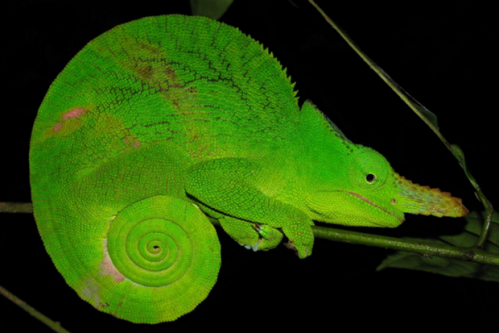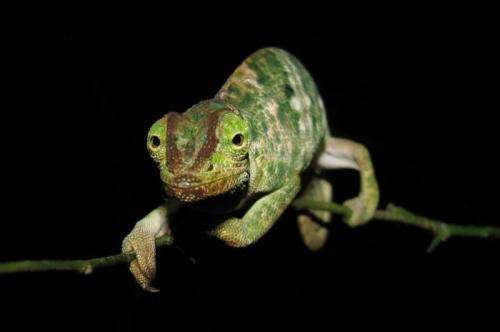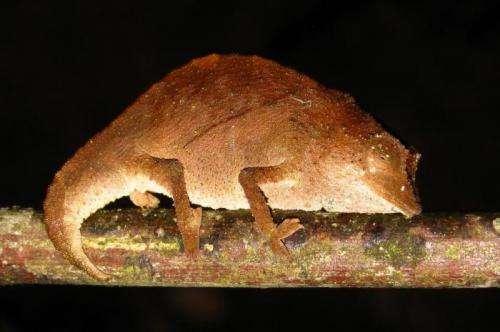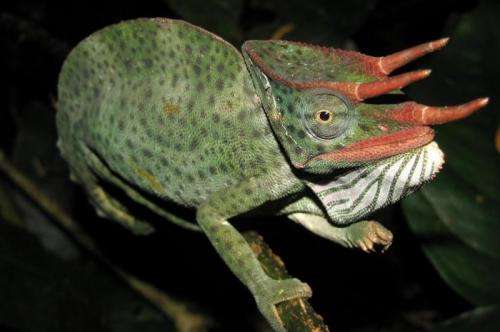Habitat loss and fragmentation reduce chameleon population in Tanzania

(Phys.org) —Tucked away among the lush rainforests of the Eastern Arc Mountains of Tanzania are a host of species of plants and animals found nowhere else in the world.
Among them are a variety of chameleon species differing in size, color and how they use their forest dwelling. However, all of them rely on the rainforest for survival.
In the past 50 years, the chameleon populations in the montane rainforests of Tanzania have declined by more than 60 percent from historical levels due to habitat loss and fragmentation, according to a new study by Virginia Commonwealth University biologists.
In the study, published in Diversity and Distributions, a top organismal conservation journal, researchers surveyed three chameleon species in the East Usambara Mountains of Tanzania using a hierarchical, distance-sampling model.
"This study is important because it combines an impressive field effort (more than 30 km of remote montane rainforest transects surveyed across two years) with novel statistical and spatial analytical approaches," said co-lead author James Vonesh, Ph.D., professor of biology in the VCU College of Humanities and Sciences.
"It shows how changes in forest cover during the past 50-plus years have impacted a poorly studied group of endemic vertebrates in an imperiled global biodiversity hotspot," he said.

Rhampholeon temporalis is a small, brown, hornless, leaf-litter chameleon that spends its time on or just above the forest floor. Trioceros deremensis is a much larger, patterned green, three-horned species that uses vegetation anywhere from just above the forest floor all the way up to the rain forest canopy. R. spinosus is a small, green-and-brown speckled species with a single spiky, but soft, horn that lives in the canopies of understory trees and above.
"Since 1950, Tanzania's human population has increased six-fold!" said Philip Shirk, a former VCU graduate student who led the study alongside Vonesh. Shirk, now in a Ph.D. program at the University of Florida, continues to collaborate with Vonesh on the project.
"As human population grows, landscapes are converted to human use, threatening forest-dependent chameleons and many other species," he said.
He added that although some of these forests are now protected, usually to provide ecosystem services like clean water to the growing human population, "it's also important to know what's happening to the many species that entirely rely on these forests for their existence."
According to Shirk, little is known about natural chameleon populations and it is not known, for most species, how many live in the wild. The same goes for many of the species that are exported for the international pet trade.
"Our research generated the first population abundance estimates for any Tanzanian chameleons, and is being used by the IUCN Chameleon Specialist Group to help determine these species' extinction risk," Shirk said. IUCN is the International Union for Conservation of Nature – the world's largest global environmental organization.

"The findings will also be used by Tanzanian authorities to help set export quotas for these species," he said.
The team has plans to expand the research and will examine more species in a larger geographical area. They are interested in how other factors, such as climate change, may impact chameleons remaining in the protected areas.
Vonesh and Shirk collaborated with biologists and conservationists from Michigan State University, University of Maine, Paul Smith's College and the University of Dar es Salaam in Tanzania.

The article is titled, "Impact of Habitat Alteration on Endemic Afromontane Chameleons: Evidence for Historic Population Declines Using Hierarchical Spatial Modeling."
More information: Shirk, P. L., Linden, D. W., Patrick, D. A., Howell, K. M., Harper, E. B., Vonesh, J. R. (2014)," Impact of habitat alteration on endemic Afromontane chameleons: evidence for historical population declines using hierarchical spatial modelling." Diversity and Distributions. doi: 10.1111/ddi.12239
Journal information: Diversity and Distributions
Provided by Virginia Commonwealth University




















